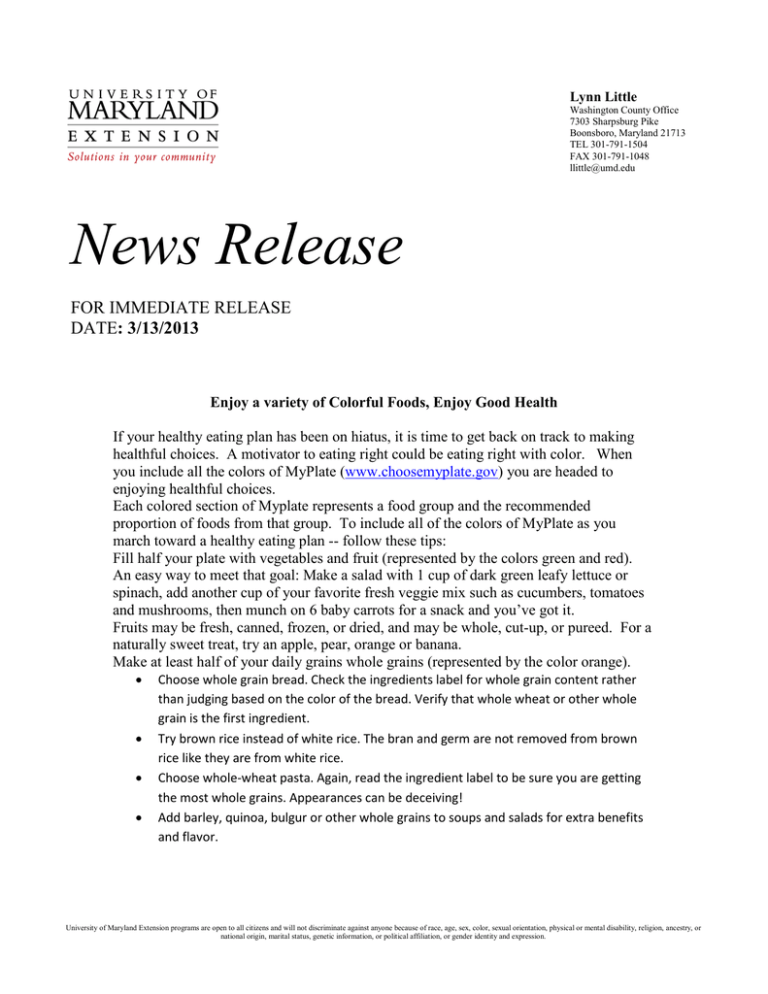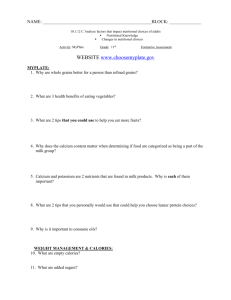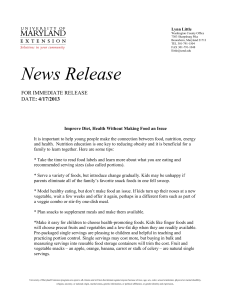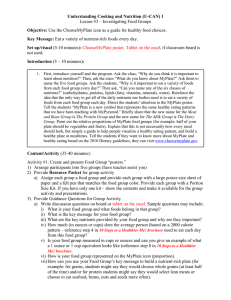Lynn Little
advertisement

Lynn Little Washington County Office 7303 Sharpsburg Pike Boonsboro, Maryland 21713 TEL 301-791-1504 FAX 301-791-1048 llittle@umd.edu News Release FOR IMMEDIATE RELEASE DATE: 3/13/2013 Enjoy a variety of Colorful Foods, Enjoy Good Health If your healthy eating plan has been on hiatus, it is time to get back on track to making healthful choices. A motivator to eating right could be eating right with color. When you include all the colors of MyPlate (www.choosemyplate.gov) you are headed to enjoying healthful choices. Each colored section of Myplate represents a food group and the recommended proportion of foods from that group. To include all of the colors of MyPlate as you march toward a healthy eating plan -- follow these tips: Fill half your plate with vegetables and fruit (represented by the colors green and red). An easy way to meet that goal: Make a salad with 1 cup of dark green leafy lettuce or spinach, add another cup of your favorite fresh veggie mix such as cucumbers, tomatoes and mushrooms, then munch on 6 baby carrots for a snack and you’ve got it. Fruits may be fresh, canned, frozen, or dried, and may be whole, cut-up, or pureed. For a naturally sweet treat, try an apple, pear, orange or banana. Make at least half of your daily grains whole grains (represented by the color orange). • • • • Choose whole grain bread. Check the ingredients label for whole grain content rather than judging based on the color of the bread. Verify that whole wheat or other whole grain is the first ingredient. Try brown rice instead of white rice. The bran and germ are not removed from brown rice like they are from white rice. Choose whole-wheat pasta. Again, read the ingredient label to be sure you are getting the most whole grains. Appearances can be deceiving! Add barley, quinoa, bulgur or other whole grains to soups and salads for extra benefits and flavor. University of Maryland Extension programs are open to all citizens and will not discriminate against anyone because of race, age, sex, color, sexual orientation, physical or mental disability, religion, ancestry, or national origin, marital status, genetic information, or political affiliation, or gender identity and expression. • Eat gluten-free oatmeal and get the added heart health benefits from the soluble fiber. Quick cooking oatmeal is a good choice if you are in a hurry. Dairy foods (represented by the color blue) is the largest contributor of calcium to your diet. Calcium is critical for healthy bones. Dairy foods also are a good source for protein and vitamins A and D. If you’re lactose intolerant, you can still enjoy lactose-free options. Switch to fat-free or low-fat (1%) milk to minimize the amount of saturated fat in your diet. Choosing calcium-fortified foods and beverages may not include other nutrients naturally present in milk and milk products. Protein foods (represented by the color purple) include meat, poultry, fish, dry beans or peas, eggs, nuts and seeds. For the healthiest options, eat fish, nuts and seeds for their heart-healthy oils more often, and choose lean cuts of meat and poultry. Although oils are not a food group, they do provide essential nutrients and are therefore included in USDA recommendations for what to eat, with only small amounts being recommended. While consuming some oil is needed for health, oils still contain calories. Oils pack about 40 calories per teaspoon. To minimize total calories use an oil spray when cooking. As you march toward a healthy eating plan, don’t forget to also be physically active. Visit www.choosemyplate.gov for more advice and guidance. University of Maryland Extension programs are open to all citizens and will not discriminate against anyone because of race, age, sex, color, sexual orientation, physical or mental disability, religion, ancestry, or national origin, marital status, genetic information, or political affiliation, or gender identity and expression.




